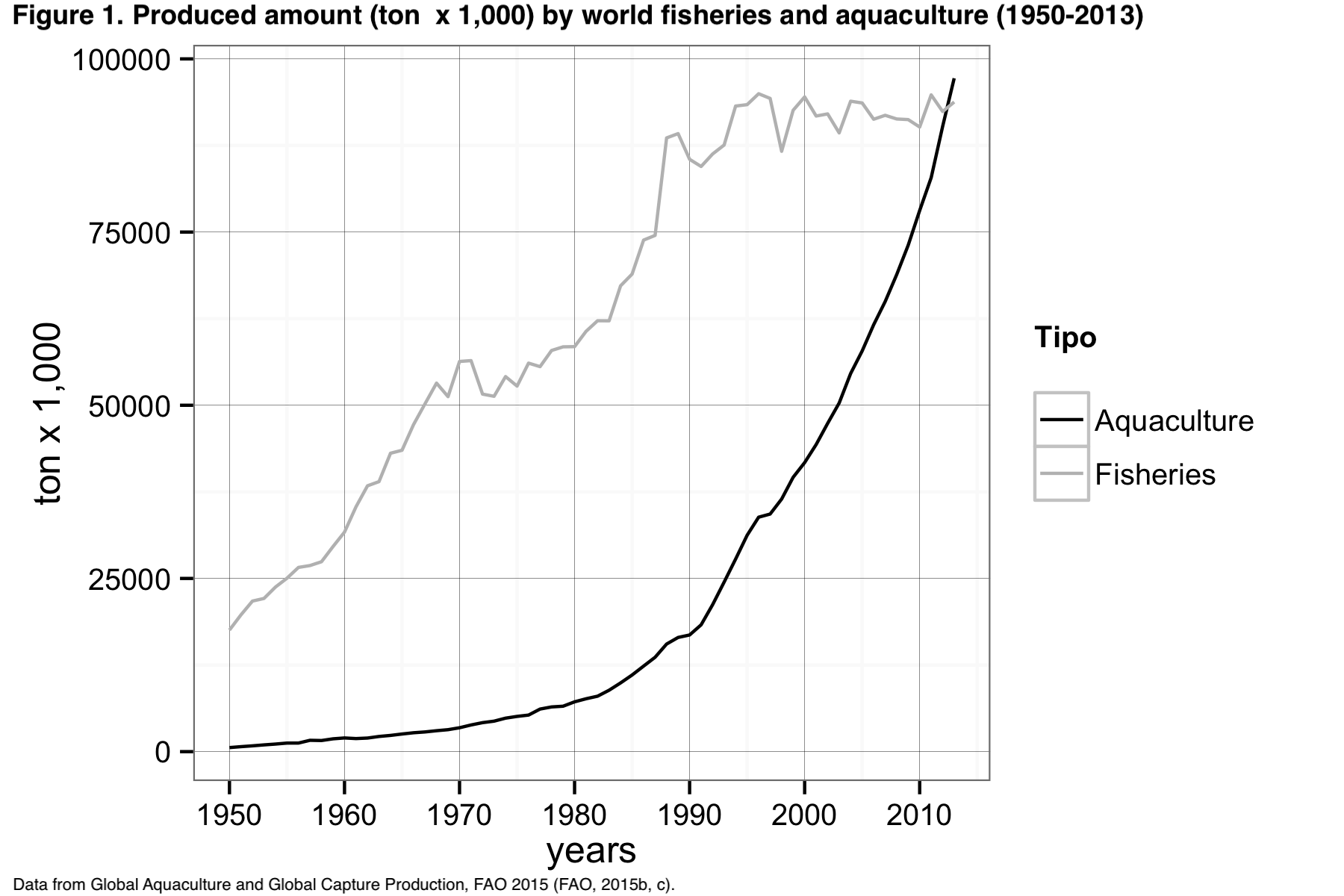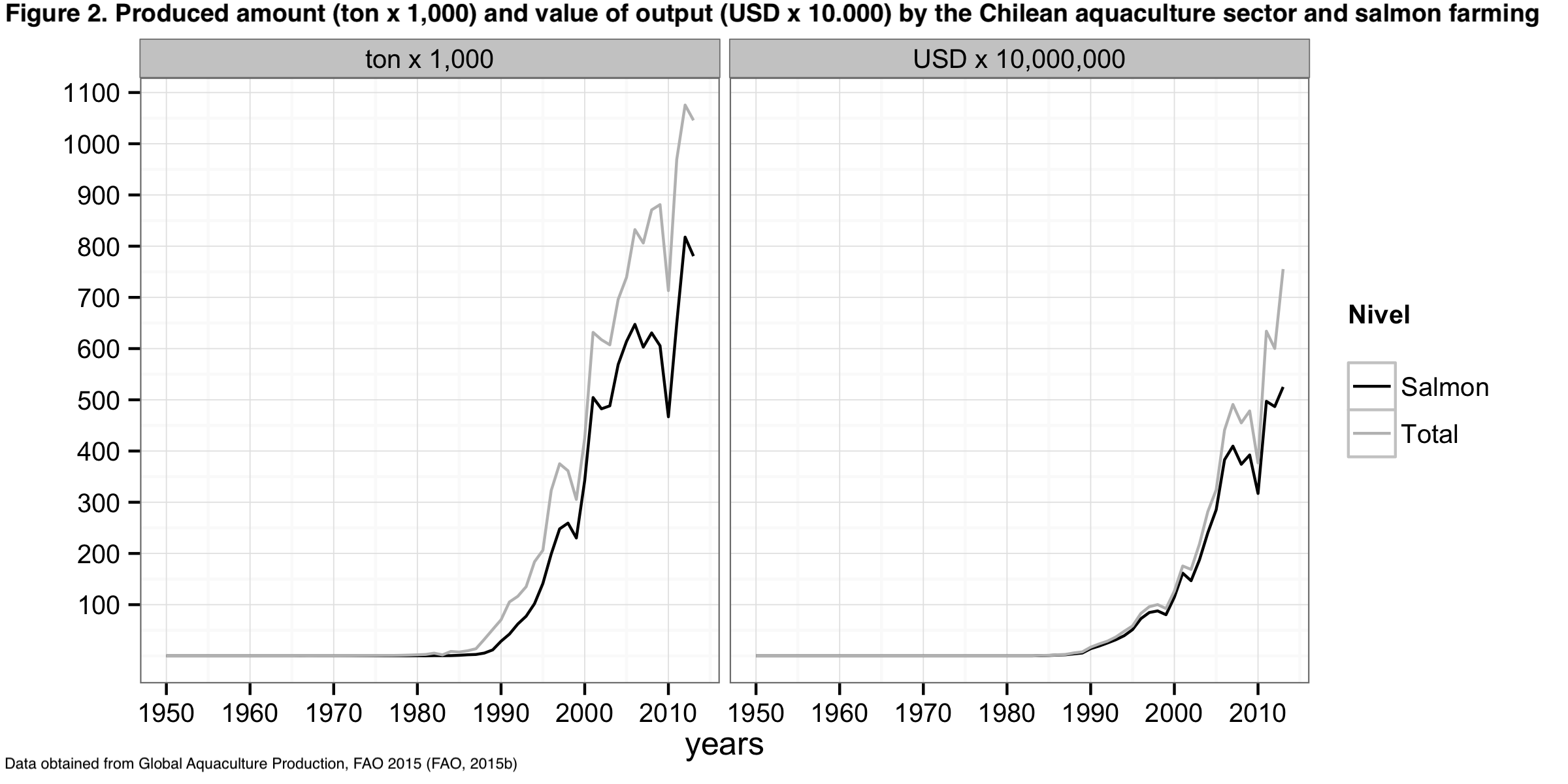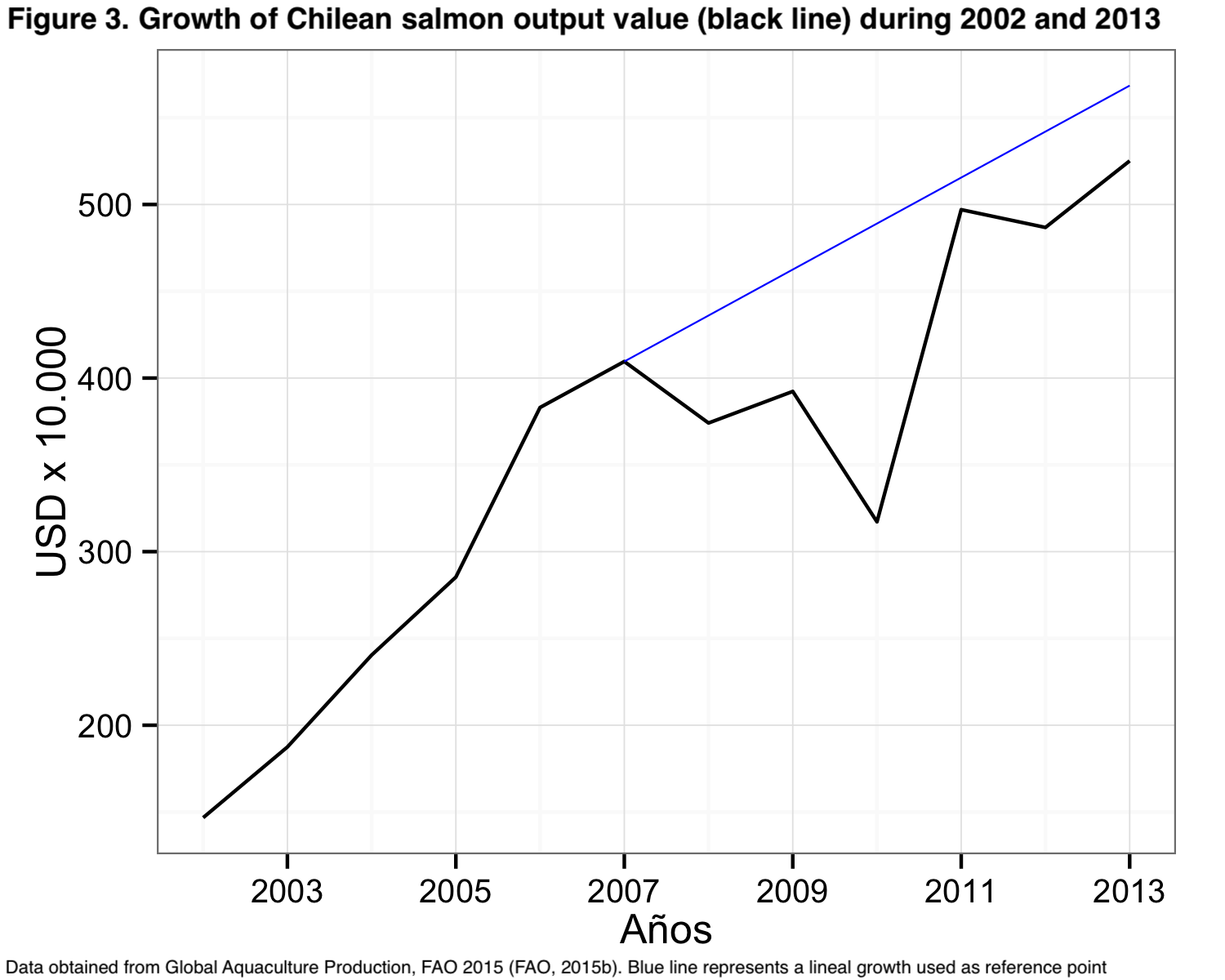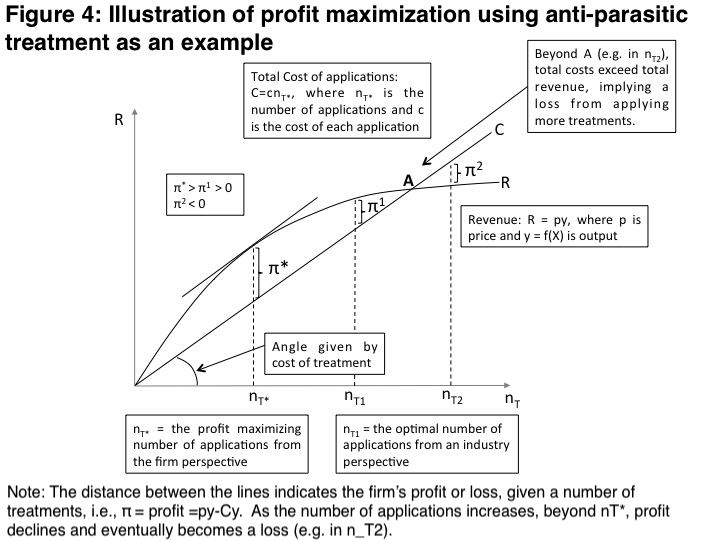Economic Analysis on Fish Health Management
Sanitary management has become a major determinant of profitability and sustainability of big animal industries in the world, such as the Chilean salmon industry. The use of veterinary epidemiology and economics as integrated fields that provide tools to establish health-productive strategies is essential

👉 see the original article here
Translation to English:
Introduction
Economics and epidemiology can be utilized in complimentary manner to improve animal health management (Rich et al., 2005a; Rich et al., 2005b; Jarvis and Valdes-Donoso, 2015), including in fisheries and in aquaculture. Aquaculture has provided livelihoods and direct and indirect income, contributing to the economic development and welfare of communities (FAO, 2012). By 2050, human population is expected to increase by 30%, implying an increase on food demand and, particularly in animal protein (Tilman et al., 2002). In specific, fish meat is considered an important and healthy source of proteins and rising demand is expected to promote expansion of the aquaculture sector throughout the world (FAO, 2013). Thus, since the 1950’s, aquaculture production has grown at an annual rate of at least 7% (Bondad-Reantaso et al., 2005), further stimulated by the stagnation of natural fisheries output (Figure 1), (Bostock et al., 2010; Perlman and Juárez-Rubio, 2010).

While countries in Asia are the mayor players in aquaculture, accounting for 89% and 71%, respectively, of production and value of total output, salmon production –a high value commodity - has been dominated by Norway (~33%) and Chile (~31%) (Bjørndal, 2002; Bondad-Reantaso et al., 2005; FAO, 2012, 2013, 2015a). Despite that the salmon farming has become the main aquaculture activity in Chile (Figure 2), numerous issues may constrain its longer run development. For instance, the costs of labor, technological transfer capabilities, the exhaustion of natural recourses and important sanitary issues, in addition to poor governmental policy and private management.

Sanitary situation of the Chilean salmon industry
Animal diseases constitute an important constraint on production systems. According to the World Organization for Animal Health (OIE), diseases may reduce the potential production of world animal food by as much as 20%, while also threatening human health and worsening animal welfare (OIE, 2014). In this article, we focus on the diseases that have affected the Chilean salmon industry. A classic example is the outbreak of the infectious salmon anemia virus (ISAv) in 2007 (Mardones et al., 2009; Mardones et al., 2013; Mardones et al., 2014). Between 2009 and 2011, estimates suggest the disease reduced salmon production by 700,000 tons, or by roughly over $2 billion (Asche et al., 2009).
However, the disease-related losses go beyond the decline in production thus might continue to grow after 2011. While providing an estimate of the cumulative loss due to ISAv is beyond the scope of this paper, it is fairly easy to demonstrate that these losses are likely increasing. Figure 3 illustrates the growth of Chilean salmon value over time. Growth accelerates in 2006, slows in 2007 – the first year of the epidemic, and then declines absolutely for three years before recovering in 2011. Nonetheless, value then dips again in 2012 before recovering in 2013. One might estimate the output value that would have occurred without the disease by extrapolating the average growth rate for the period 2002 – 2006, or for 2002 – 2007. Each would provide a rising line well above of the actual value observed. Indeed, even a linear projection of the increase in value produced in 2007 would lie significantly above actual value (figure 3). The implied loss of output value is then the difference between the projected output values and the actual observed. A simple calculation shows that loss (the area between the black and blue lines in figure 3) would exceed $3 billion. Moreover, Figure 3 suggests that the loss is probably continuing to grow, perhaps because disease reduced the quality of the natural resource within which salmon are being raised, or perhaps because ISA reduces output quality, modified the Chilean salmon industry structure or, simply, it damaged the image of Chilean salmon over consumers, causing Chile to suffer lower prices or lose market share, at least temporarily. Also, we should consider that, due to new regulations, production costs have also been higher, beside of fluctuation on supply and its consequent distortion on market prices (Asche and Bjorndal, 2011; MH, 2015). Therefore, the economic impacts might go beyond to the observed decrease on amount of production. The point of this brief exercise is, simply, to illustrate that the impacts of a disease go beyond the short term, as well as to emphasize that when disease outbreaks are not well controlled, may lead to very large economic losses for both the industry involved and the national economy.

While ISA outbreaks have declined, the salmon industry in Chile still suffers from other disease issues. For example, Sernapesca reported that average monthly mortality of sea farms fluctuated between 0.88 and 1.4% (Sernapesca, 2015). More than 70% of the reported mortality in farms with Atlantic salmon and rainbow trout is caused by the Salmon Rickettsial Septicemia (SRS) (Sernapesca, 2015). That disease, caused by the bacteria Piscirickettsia salmonis, is also chiefly responsible for the large use of antibiotics by the Chilean salmon industry (Niklitschek et al., 2013), which has caused some international retailers to reduce the amount purchased from Chile (e.g.. Costco USA ). The prevalence of Sea Lice (or Caligidosis), a disease caused by a copepod parasite (Caligus rogercresseyi), has also remained prevalent over time, though with a strong seasonal fluctuation. This disease, like others, reduces fish growth rates and thus extends the production cycle, increasing production costs. It also reduces the quality of the final output (skin and muscle damage) and also facilitates the occurrence of other diseases, generating direct and indirect losses (Abolofia, 2014).
Economics and health management in salmon fish production
As economists, we assume that firms attempt to maximize their profits (π), subject to a budget constraint (B), by the optimal selection of a productive strategy. Simply put, profit maximization is given by: 〖max〗_π=py-cy s.t. B (1)
Where p is price of output, y is total output given a strategy of production (y=f(X)), and c is the cost of production given y. Of course, market prices, costs, and productivity may vary in both expected and unexpected ways. For example, firms that produce salmon face constant challenges due to the complex sanitary situation that is an inherent result of the industry’s structure and the environmental features within which the industry has developed. One or several actions to prevent, control or eradicate a disease will result in an increase of production costs (c) for the firm. However, failure to control a disease will eventually reduce output (y) and/or quality, thereby reducing market price (p). A rational solution to this problem is the selection of a strategy that will maximize net profits, such as the application of antibiotics to control or eradicate the disease. Nonetheless, the firm may not select the strategy that is best in the long run, either for itself or, especially, for the industry as a whole.
For example, a firm may decide that the best strategy is to use anti-parasitic treatment to control Sea Lice. However, as anti-parasitic treatments are costly, the firm will probably decide to apply only a given number (n_T) of treatments in each productive cycle achieving the highest short run profit by reducing the damage caused by Sea Lice . However, it may be that this decision (apply n_T treatments) does not contribute to significantly reduce parasite loads in the area in a beneficial way from an industry viewpoint. The failure to further reduce Sea Lice loads has two possible effects: first, the prevalence of Sea Lice will increase, instead decrease, requiring a greater number of treatments per productive cycle in future years, this without considering possible effect on efficiency of repeated treatments over time. Thus, it might have been more profitable for the firm to take a longer-term view and spend more in the short run to further reduce loads. However, the individual firm might not have the financial resources to do so, or it might imagine that it will be re-infested by parasites from other firms who it imagines will not eradicate their parasites. Second, if the firm does not further reduce its Sea Lice, the higher prevalence of Sea Lice could significantly increase the risk to other firms that they will be infected. Thus, those other firms would theoretically like to encourage the infested firm to further reduce its Sea Lice, but they may not have a mechanism to do so.
It can easily be demonstrated that it may often appear more profitable for the individual firm to apply a smaller number of disease treatments (n_(T) in figure 4) than is in fact desirable from an industry viewpoint (n_T1 in figure 4). If the cost of treatment is significant, the firm may decide that only a few treatments are worthwhile given the the marginal cost regarding to marginal benefits of use of treatments. However, given n_(T), the presence of the may remain sufficiently high to spread more easily to other firms in the general area. This is a particularly important issue when firms are spatially grouped and where a disease may be easily spread through the environment (e.g., via water). Thus, if individual firms each apply too few treatments (e.g. n_(T)), instead of the disease being controlled and/or eradicated, the disease may spread widely, causing increasing losses and, through degradation of the environment, requiring much greater costs (C) in the future.

As the former example demonstrates, decisions that aim to maximize profit for the individual firm may not be welfare maximizing for the industry. Decisions by the firm must take account of long run as well as short run effects on its own profits and, in an industry in which the effects of one firm’s actions on other’s firms (externalities ) are common and important. Following the example of Sea Lice control, the short run economic optimum (n_(T*)) may be insufficient to avoid Sea Lice spread to other sea-farms (a negative externality), perpetuating the disease in the region. It may be that a rather small increase in the number of treatments to 〖n_T〗^1, that might match the coordinate anti-parasitic strategies dictated by Sernapesca, while not profit maximizing for firms in the short run, is nonetheless a efficient long–run strategy precisely because it leads to control of the disease in the area. In fact, it has been demonstrated theoretically that coordinated strategies can reduce the prevalence of diseases, particularly Sea Lice and ISAV (Valdes-Donoso et al., 2013).
Following same logic, during the ISAV epidemic in Chile, Sernapesca implemented a series of regulations aiming to control the disease. These regulations sought to remove positive stocks by culling or by the early harvesting of positive salmon; increase biosecurity, control of movements and manage the disposal of dead fish. Although these regulations were theoretically well designed, it appears that several factors caused them to fail, allowing the further spread of ISA through all regions with salmon sea farms in Chile. For example, the low level of knowledge in biosecurity implementation by the industry, poor regulations for the aquaculture sector, complex sanitary scenarios (specially given by outbreaks of SRS and high loans of Sea Lice), insufficient firm action to remove quickly positive stocks from water may have contributed to ISA spread in Chile (Alvial et al., 2012). Regulations implemented by Sernapesca assumed that firms would immediately adopt the new regulations even though they would immediately increase production costs (e.g., increased monitoring and sampling), and that the direct and indirect losses brought about by culling or early harvesting would be absorbed exclusively by affected firms. Instead, firms sought to limit their short term losses by delaying the reporting of infections (positive samples) and retained their stocks in the water as long as possible. In fact, decisions conform to a productive logic, such as the management and disposal of large volumes of dead fish, transfer of infected fish from one place to another, using same means of transport and machinery between positive and negative farms, etc., probably contributed to the failure of the control of ISA in Chile during 2007 and 2011. Here, actions driven by a short run economic logic resulted in long run damage for individual firms and for the entire industry (Figure 3). Perhaps a timely epidemiological knowledge of risk factors and the adequate prognosis of disease progression (Mardones et al., 2013; Mardones et al., 2014), in addition to private or public subsidies to encourage appropriate firm behavior would achieve quicker and more appropriate actions and result in significant social benefit in the long run.
In these two examples, which are representative of many others that could be cited in animal food industries throughout the world, we observe that firms’ individual incentives may diverge from the social or common good, and thus negatively affect industry sustainability. This concept, well known as the “tragedy of the commons” has been widely studied in economics, particularly in how the profitability of individual actors could improve if they could behave less individualistically, i.e., work more collectively (Schelling, 1929; Keohane and Olmstead, 2007).
Discussion
Sanitary management has become a major determinant of profitability and sustainability of big animal industries in the world, such as the Chilean salmon industry. The use of veterinary epidemiology and economics as integrated fields that provide tools to establish health-productive strategies is essential. The benefits and costs generated by actions aimed to prevent, control and eradicate animal diseases must be weighed in a short and long term horizon. At the same time, the analysis must be addressed from different perspectives, e.g. firm, industry and society as a whole. Economists, veterinary epidemiologists, fish production professionals, and regulatory officials should work closely together as the perspective of each is crucial to developing a feasible and effective disease management strategy.
In the absence of immediate incentives to execute actions that aim to reduce risk of diseases, regulation is important. For example, firms often improve biosecurity to protect their stocks from outside threats. Improving biosecurity can involve changes in management, increased attention to purchase disease-free replacements, and changes in physical infrastructure. Interestingly, however, while firms have incentive to protect themselves from outside threats, they have much less incentive to protect others from the threats they generate after they become diseased. This has been a major issue for the salmon industry, as infected firms have strong incentive to continue operating to maximize their own profits without concern for others, even when it might be better for society as a whole for them to alter their operations dramatically, or even shut down.
As the examples make clear, given the likelihood that disease can spread, firms producing salmon (and other aquatic animals) can generate significant negative externalities, i.e., harm to other firms and/or humans. As the market mechanism does not reflect these externalities, firms have no monetary incentive to pay attention to them. That situation changes only if regulations are passed enabling the development of incentives that encourage firms to take account of how their actions affect others. This requires government action, in cooperation with the industry and other elements of society, to ensure that the regulations are designed appropriate and harmonically with the productive environment.
Finally, in the article “A Selective Review of the Economic Analysis of Animal Health Management”(Jarvis and Valdes-Donoso, 2015) we offer more details of some concepts discussed briefly here. In such article we have selected some researches with the aim of incentive the discussion of the role of economics in animal health management, and how both fields, economics and veterinary epidemiology, could improve their results by working together.
Acknowledgments
Pablo Valdes-Donoso has been granted by Chile to develop his Masters and PhD studies at the UC Davis in the US, focused in animal health economics. Authors acknowledge the intellectual exchange with Chilean professionals from the academia, government and the salmon industry, all of those motivated to improve the sustainability of this sector towards a contribution in the growth of Chile.
Bibliography
- Abolofia, J.N., 2014. The Bioeconomics of a Common Property Pest: Parasitic Sea Lice and Farmed Salmonids. Agriculture and Resource Economics. University of California Davis, Davis CA, 206.
- Alvial, A., Kibenge, F., Forster, J., Burgos, J.M., Ibarra, R., St-Hilaire, S., 2012. The Recovery of the Chilean salmon industry: The ISA crisis and its consequences and lessons. Global Aquaculture Alliance. Puerto Montt.
- Asche, F., Bjorndal, T., 2011. The economics of salmon aquaculture.
- Asche, F., Hansen, H., Tveteras, R., Tveteras, S., 2009. The Salmon Disease Crisis in Chile. Mar Resour Econ 24, 405-411.
- Bjørndal, T., 2002. The competitiveness of the Chilean salmon aquaculture industry. Aquaculture Economics & Management 6, 97-116.
- Bondad-Reantaso, M.G., Subasinghe, R.P., Arthur, J.R., Ogawa, K., Chinabut, S., Adlard, R., Tan, Z., Shariff, M., 2005. Disease and health management in Asian aquaculture. Veterinary parasitology 132, 249-272.
- Bostock, J., McAndrew, B., Richards, R., Jauncey, K., Telfer, T., Lorenzen, K., Little, D., Ross, L., Handisyde, N., Gatward, I., Corner, R., 2010. Aquaculture: global status and trends. Philosophical transactions of the Royal Society of London. Series B, Biological sciences 365, 2897-2912.
- FAO, 2012. The State of World Fisheries and Aquaculture. http://www.fao.org/docrep/016/i2727e/i2727e.pdf.
- FAO, 2013. Food Outlook. Biannual Report on Global Food Markets., http://www.fao.org/docrep/019/i3473e/i3473e.pdf.
- FAO, 2015a. Aquaculture topics and activities. State of world aquaculture. Text by Rohana Subasinghe. Fisheries andAquaculture Department. FAO, http://www.fao.org/fishery/topic/13540/en.
- FAO, 2015b. Global Aquaculture Production. In: Collections, F.S. (Ed.), Fisheries and Aquaculture Department.
- FAO, 2015c. Global Capture Production. In: Collections, F.S. (Ed.), Fisheries and Aquaculture Department.
- Jarvis, L.S., Valdes-Donoso, P., 2015. A Selective Review of the Economic Analysis of Animal Health Management. Journal of Agricultural Economics, n/a-n/a.
- Keohane, N.O., Olmstead, S.M., 2007. Markets and the environment. Island Press Washington.
- Mardones, F.O., Jansen, P.A., Valdes-Donoso, P., Jarpa, M., Lyngstad, T.M., Jimenez, D., Carpenter, T.E., Perez, A.M., 2013. Within-farm spread of infectious salmon anemia virus (ISAV) in Atlantic salmon Salmo salar farms in Chile. Diseases of aquatic organisms 106, 7-16.
- Mardones, F.O., Martinez-Lopez, B., Valdes-Donoso, P., Carpenter, T.E., Perez, A.M., 2014. The role of fish movements and the spread of infectious salmon anemia virus (ISAV) in Chile, 2007–2009. Preventive veterinary medicine.
- Mardones, F.O., Perez, A.M., Carpenter, T.E., 2009. Epidemiologic investigation of the re-emergence of infectious salmon anemia virus in Chile. Diseases of aquatic organisms 84, 105-114.
- MH, 2015. Salmon Industry Handbook. In: Harvest, M. (Ed.).
- Niklitschek, E.J., Soto, D., Lafon, A., Molinet, C., Toledo, P., 2013. Southward expansion of the Chilean salmon industry in the Patagonian Fjords: main environmental challenges. Reviews in Aquaculture 5, 172-195.
- Perlman, H., Juárez-Rubio, F., 2010. Industrial Agglomerations: The Case of the Salmon Industry in Chile. Aquaculture Economics & Management 14, 164-184.
- Rich, K.M., Miller, G.Y., Winter-Nelson, A., 2005a. A review of economic tools for the assessment of animal disease outbreaks. Rev Sci Tech 24, 833-845.
- Rich, K.M., Winter-Nelson, A., Miller, G.Y., 2005b. Enhancing economic models for the analysis of animal disease. Rev Sci Tech 24, 847-856.
- Schelling, T.C., 1929. Micromotives and Macrobehavior. W. W. Norton & Company, Inc. United States of America.
- Sernapesca, 2015. Informe sanitario. Salmonicultura en centros marinos. Tilman, D., Cassman, K.G., Matson, P.A., Naylor, R., Polasky, S., 2002. Agricultural sustainability and intensive production practices. Nature 418, 671-677.
- Valdes-Donoso, P., Mardones, F.O., Jarpa, M., Ulloa, M., Carpenter, T.E., Perez, A.M., 2013. Co-infection patterns of infectious salmon anaemia and sea lice in farmed Atlantic salmon,Salmo salarL., in southern Chile (2007-2009). Journal of fish diseases 36, 353-360.